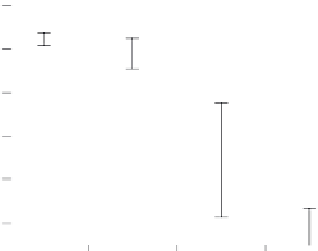Environmental Engineering Reference
In-Depth Information
grasses). Figure 11.9 shows that pest aphid abundance is actually predicted to
decline under global climate change, particularly for the medium to high CO
2
sce-
narios. It is important to recognize that climate change is likely to 'improve' cir-
cumstances for particular species (whether pests, invaders, harvested species or
endangered ones) while it makes things more precarious for others.
11.3.3
Harvesting
fi s h i n f u ture - cod
willing
Mean annual temperature at the sea surface is predicted to increase in the North
Sea by up to 1˚C by 2040 and the population dynamics of fi sh may respond via
changes to their rates of growth, birth and death. The situation is further compli-
cated because the raised temperatures may change habitable areas, just as for
terrestrial plants and animals. Kell et al. (2005) modeled the outcomes of climate
change for cod (
Gadus morhua
), contrasting the effects of a likely change in juvenile
survival as opposed to the expected reduction in habitable area. These two fi shery
models were evaluated for three climate change scenarios (Figure 11.10a): a best
case scenario that assumes no increase in average temperature after 2001, a worst
case scenario with a constant increase of 0.026˚C per year (i.e. 1˚C increase by 2040)
and an intermediate scenario of a 0.2˚C increase by 2040 (based on a model from
the Hadley Center - like the one in Figure 11.2).
Recall, from Box 7.1, that a recruitment curve is a plot of net recruitment (births
minus deaths) of a fi sh population versus the total size of the population (standing
stock biomass). For any given stock biomass, a fi shery can harvest all the associated
net recruitment without depleting the stock - so that, in theory, the harvest is sus-
tainable. The
maximum
sustainable yield (MSY), then, is the one at the highest point
of the dome-shaped recruitment curve.
When the only effect of increased temperature is on fi sh survival (recruitment
curves in Figure 11.10b), there is no change to the critical standing stock biomass
at which the MSY is available - but the actual size of the yield is reduced. On the
other hand, both the critical standing stock biomass and the size of the yield are
reduced when increased temperature causes the habitable area of cod to shrink
(Figure 11.10c). Setting aside the real diffi culties of using recruitment curves to
manage fi sheries (Chapter 7), these results nevertheless provide valuable insights
into the potential consequences of climate change for fi sheries management
decisions.
Fig. 11.9
Predicted
decreases in mean
abundance (mean ±
standard error,
compared to baseline in
1961-90) of aphid pests
of cereal crops in
southern England
during the twenty fi rst
century assuming four
increasingly extreme
climate change
scenarios - CO
2
concentrations
increasing to 525, 562,
715 or 810 ppm,
respectively. This is a
case where climate
change may bring a
benefi cial response.
(After Newman, 2005.)
1.1
0.9
0.7
0.5
0.3
0.1
Low
Med low
Med high
High




















































Search WWH ::

Custom Search